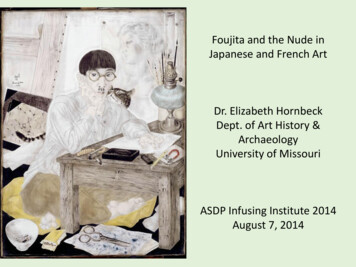
Transcription
Foujita and the Nude inJapanese and French ArtDr. Elizabeth HornbeckDept. of Art History &ArchaeologyUniversity of MissouriASDP Infusing Institute 2014August 7, 2014
Fujita Tsuguji (Tsuguharu), 1886-1968a.k.a. Léonard Foujita b. 1886 Studied Western painting with Kuroda Seiki atthe Tokyo School of Fine Arts; graduated in1910 Continued studies with Wada Eisaku, who hadstudied painting in France from 1899-1903 1913: Foujita went to Paris with theencouragement of Mori Ōgai By 1918, Foujita began to find success in Parisselling his artwork with help from his firstwife, Fernande Vallé, an important art dealer Travelled in Europe and South America 1933: returned to Japan, remaining thereuntil 1950 when he moved back to France 1934: 27 of his paintings were shown inTokyo at a special exhibition held by theNikakaiPhotograph of Foujita by Ansel Adams (n.d.)
Fujita Tsuguji (Tsuguharu), 18861968a.k.a. Léonard FoujitaSelf Portrait, 1926,oil on canvas, 81 x 61 cm.Musée des Beaux-Arts de LyonFoujita developed a unique style(his so-called grand fond blanc) offinely drawn lines of constantwidth on a milky whitefoundation.Dessin (drawing) vs. tableaux(paintings)Eventually he became known as“a painter of cats and nudes.”
Foujita, Head of a Girl, 1926pen and black ink and graphitewith stumping23.9 cm. x 20 cm.Detroit Institute of Arts
Foujita, Self Portrait with Cat, 1927, drypoint,13 x 9 3/4 in., Dallas Museum of ArtFoujita, Mother and Child, 1924,pen and ink on white paper,12 1/8 x 7 3/16 in.Minneapolis Institute of Arts
Anonymous Japanese artist of the ukiyo-e school, Courtesan and Attendant SelectingKimono Designs, Edo period, c. 1700; hanging scroll, ink and color on silk, 128 x 62 cm.,Seattle Museum of Art
Anonymous Japanese artist of the ukiyo-e school, Courtesan and Attendant SelectingKimono Designs, detail—notice the extreme linearity of the woman’s facial features andher hands outlined in front of her chest. This is the linearity that Foujita took fromJapanese artistic traditions. Notice that the kimono and the small pot she is holding inher left hand have much more form and detail than does the model’s flesh.
Edouard Manet, Portrait of EmileZola, 1860sFrench painter Edouard Manet,like many 19th-century painters inFrance, was strongly influenced byJapanese prints (he included onein his portrait of Zola). The linearquality of Japanese woodcuts canbe seen in Manet’s famous nude,Olympia (1863).
Edouard Manet, Olympia, 1863
Manet combined Japanese influencewith the European tradition of nudepainting. Compared with Titian’spainting (below), Manet’s space isflattened out, and the subject’s body isless modelled. Manet resisted Europeanillusionism to help create a “modern”aesthetic in Western painting.Edouard Manet, Olympia,1863Titian, Venus of Urbino,1538
Foujita’s nude (below) takes Manet’sinnovations to a further extreme offlatness and linearity. Notice thecontrast between the nude subject andthe highly detailed illusionism of thetextiles framing her (an homage to thecurtain pulled back in the upper leftcorner of Manet’s painting).Edouard Manet, Olympia,1863Foujita, Nude, 1922
Foujita, Nude (Nu couché à la toile de Jouy), 1922; crayon, pen, black chalk, and oil oncanvas, 130 x 195 cm., Musée d’art modern de la ville de Paris“One day it occurred to me that Japan has produced only a small number of nudes. Ihappened to realize that [the woodblock print artists] Harunobu and Utamaro onlyexposed part of a leg or knee in order to convey the real feel of skin. It was then that Idecided to attempt to convey the real feeling of skin as my own beautiful matière , and soI turned again to the painting of nudes after an interval of eight years. . . . I began toreproduce the softness and smoothness of skin, inventing a canvas surface whose verytexture has the appearance of skin.” (Foujita)
Foujita, Nude (Nu couché à la toile de Jouy), 1922; crayon, pen, black chalk, and oil oncanvas, 130 x 195 cm., Musée d’art modern de la ville de ParisJ. Thomas Rimer, in Paris in Japan: The Japanese Encounter with European Painting, 1987(p. 100):“By 1920, Fujita had developed his ‘trademark’ style, paintings in elegant design,often of women, in which their flesh was painted as an undulating surface outlined inblack, providing a combination of linear clarity and sensuous tactility unusual in French
Foujita, Nude (Nu couché à la toile de Jouy), 1922; crayon, pen, black chalk, and oil oncanvas, 130 x 195 cm., Musée d’art modern de la ville de ParisJ. Thomas Rimer, in Paris in Japan: The Japanese Encounter with European Painting, 1987(p. 100):“Fujita’s originality resulted, at least in part, from his successful juxtaposing ofEastern and Western techniques. For example, his application of semi-transparentWestern oil pigments in light washes is redolent of oriental ink and watercolor painting
Foujita, Two Nudes, 1927; color etching, roulette, aquatint, and open bite with scrapingon chine colle, Balitmore Museum of Art
Foujita, Two Female Nudes,1930; oil on canvas, 142 x124.5 cm., KanagawaKenritsu Kindai Bijutsukan
Foujita, Two Heads; lithograph, 31.75 x 40.323 cm., Dallas Museum of Art
Foujita, Chindon Performer and ServingMaid, 1934, watercolor on paper, 91 x73 cm.Kanagawa Kenritsu Kindai Bijutsukan(Museum of Modern Art, Kamakura)- Exhibited in Tokyo in 1934 along withtwo other works on this subject; oneTokyo critic wrote,“Fujita’s art is never realistic. His worksin the present exhibition, particularlythose dealing with Japanese customs,are his own ukiyo-e intended to createan effect akin to printing. He looks backwith nostalgia at some old dream ofJapan. All the subjects he has chosen –a sumo wrestler, a fishmonger’s servantboy, a geisha on a back street – arepurely Japanese, but he does notportray the major aspects of modernsociety. Such works may pleaseforeigners but not his Japaneseviewers.”
Foujita, Chindon Performer and ServingMaid, 1934, watercolor on paper, 91 x73 cm.Kanagawa Kenritsu Kindai Bijutsukan(Museum of Modern Art, Kamakura)- Exhibition was arranged to evaluateFoujita’s suitability for inclusion in theexclusive Nikakai artists’ group. Apanel of critics reviewing the workwrote,“His recent works, as well as thosepainted from materials gatheredtogether in Mexico, display such a senseof sadness and gloom that we find itimpossible to relate to them with anyintimacy.”There was a feeling in Japan that, “this isan artist whose time has passed.”
Shunga: Sex and Pleasure inJapanese Art, 2013, ed.Timothy Clark et. al. (BritishMuseum AEC)Japanese Erotic Art,Ofer Shagan, 2013Timon Screech, Sex and theFloating World: Erotic Imagesin Japan, 1700-1820, 1999.Shunga: Erotic Art in Japan, byRosalind Buckland, 2013
Timon Screech, Sex and the FloatingWorld: Erotic Images in Japan, 17001820, University of Hawai’i Press, 1999.-Morishima Chūryō, 1787, explained toJapanese readers that learning todraw the human body was regardedas the cornerstone of Western art,and grasping the fundamentaldifferences between male and femalewas essential. (p. 101)-“As the Edo regime of the bodyattached scant gender-specificity toexternal parts it accorded small eroticvalue to the shapes formed by skin, soit was not of much use for artists toshow them .it was clothing thatmade gender (and erotic) statementspowerful.” (p. 104)
Kitagawa Utamaro, Hokkoku GoshokuSum I: Teppo, woodblock print, 18th c.Kitagawa Utamaro, A Flirt from the seriesTen Studies in Female Physiognomy,woodblock print, 1791-1792
Images of sexual intercourse:makura-e pillow pictureswarai-e laughing picturesless explicit pictures of flirtation andseduction:abuna-e risky picturesnon-explicit pictures of characters fromthe demi-monde:bijin-e or bijin-ga beautifulfigure picturesnigao-e facial likeness picturesyakusha-e actor picturestoday, scholars of Edo period prints referto erotic images asshunga spring picturesin Japan they’re calledhiga secret pictures
Hokusai (1760-1849), shunga print; color woodcut, 18.3 x 25.5 cm., Fine Arts Museums ofSan Francisco
Koryusai Isoda, Thirty-Six Famous Poets: Man Dreaming, c. 1773, shunga print; 5 x 5.5cm., Royal Ontario Museum
Suzuki Harunobu, Young Man Caresses Girl, late 1760s, color print; 7.5 x 10 cm.
Manner of Kitagawa Utamaro (1754-1806), shunga print; color woodcut, 18.6 x 26.6 cm.,Fine Arts Museums of San Francisco
Katsushika Hokusai (1760-1849), Examples of Loving Couples (Tsuhi no Hinagata); from analbum of 12 erotic shunga woodcuts; color woodblock print, c. 1814; 25.1 x 36.6 cm.,Musée Guimet, Paris
Anonymous French artist, Triolism andMasturbation, 4th quarter of the 18th centuryor the 1st quarter of the 19th centuryGustave Courbet, The Origin of theWorld, 1866, oil on canvas, 46 x 55 cm,Musée d‘Orsay, ParisIn thinking about Foujita’s nudes (a distinctly Western painting genre) and the verydifferent tradition of erotic art in Japan usually involving couples rather than focusing on thefemale body alone, I was struck by the fact that French art (especially popular art, such asprints) also tended to show couples engaging in sexual activity up until the mid-19th century,when it shifted to representations of the passive female body as signifier of eroticism. Thischange in French art was spurred in part by the invention of photography.Art historian Abigail Solomon-Godeau has explored the development of “theimagery of fetishized femininity” in 19th-century France in relationship to both the“commodity fetish” based on capitalism (Marxism and Frankfurt School) and the “psychicfetish” based on sexual perversion (Freud).
Anonymous French artist, Triolism andMasturbation, 4th quarter of the 18th centuryor the 1st quarter of the 19th centuryGustave Courbet, The Origin of theWorld, 1866, oil on canvas, 46 x 55 cm,Musée d‘Orsay, ParisSolomon-Godeau points out that “iconographies that are effectively about thefeminine as spectacle” emerged in 19th century French prints and photographs. “Consistentwith their fetishistic structure, these early pinups observe the same conventional protocolsgoverning the representation of the female nude – the elision of sex organs, elimination ofbody hair (these are to be found only in pornographic representations), and often a phallicfiguration of the entire body itself. Insofar as both image and commodity promise andwithhold satisfaction while endlessly provoking desire, there is further justification in mappingtheir shared psychic purview.”
Solomon-Godeau argues that photographic erotica in 19th-century France“augments and ratifies the tendency, already apparent in lithographic prototypes, to articulatethe sexuality of femininity in terms of specularity rather than activity. Whereas traditionalgraphic pornography conceives of the sexual as active, frequently featuring a male participantas the viewer’s surrogate, photographic pornography, more often than not, devolves on thesight of the female body alone. Moreover, and with specific respect to the beaver shot, themedium of photography can be said to technically foster a radical fragmentation of the body,even as it attests to a fascination with female genitalia that makes the implicit fetishism of thelegal erotic unmistakably explicit.”Abigail Solomon-Godeau, “The Other Side of Venus: The Visual Economy of Feminine Display,”in The Sex of Things: Gender and Consumption in Historical Perspective, ed. Victoria de Grazia,with Ellen Furlough (Berkeley, Los Angeles, and London: University of California Press, 1996),pp. 113-150.
Japanese Erotic Art, Ofer Shagan, 2013 Timon Screech, Sex and the Floating World: Erotic Images in Japan, 1700-1820, 1999. Timon Screech, Sex and the Floating World: Erotic Images in Japan, 1700-1820, University of Hawai [i Press, 1999. - Morishima hūryō, 1787, explained to Japanese readers that learning to draw the human body was regarded as the cornerstone of Western art, and grasping the .











